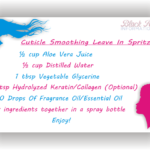 Starting a hair journey can be hard, especially if you never really took responsibility of your hair before like me. Now that the natural hair community is growing, more businesses are selling and marketing natural hair products, making it harder to choose one that will work the best.
Starting a hair journey can be hard, especially if you never really took responsibility of your hair before like me. Now that the natural hair community is growing, more businesses are selling and marketing natural hair products, making it harder to choose one that will work the best.
There are a ton of products out there that have different names but work to serve the same purpose. If you’re overwhelmed by all the product choices out there, and have no idea how to begin your hair journey, don’t panic.
Below we share the top five essential products you need to properly manage your natural hair. Do you think anything else needs to be added to this list? What are your natural hair essentials?
Shampoo
Shampoo is super important, but ironically you probably won’t use it as often as the other products listed here. Shampoo is essential to every hair journey, because we need to be able to thoroughly cleanse our scalps of dirt and product build up.
There are different types of shampoos out there, and the type you decide to use depends on you. Many shampoos sold in stores contain ‘sulfates’ which are responsible for the soap suds and squeaky clean feeling we get after washing our hair.
However, this ingredient is a drying agent, and some naturals prefer to use shampoos that don’t contain it. You can also use alternatives to shampoo like black soap or bentonite clay*.
Conditioner
Conditioner may be one of the most important pieces to a successful hair journey. It can be used in so many different ways, and it’s the product that smooths and softens our tresses.
Conditioner is the one product that I’m ALWAYS at the store buying! Make sure to pick a conditioner that has good slip to make detangling easier. If you can find a brand that makes an economy bottle size of your favorite conditioner, you’re lucky!
A variation of conditioner that you may also see is ‘co-wash’. Co-washes are basically cleansing conditioners, and they’re used to gently cleanse product build up while still moisturizing hair.
Co-washing can be done between shampoos. You can buy a cowash at the store, or you can mix tea tree oil* into your conditioner to help cleanse your scalp.
If you can, find a conditioner that can double as a leave in (such as Shea Moisture* Restorative Conditioner). Leave ins are just as important as rinse out conditioners. If you can’t find a multipurpose conditioner, you can buy a separate product from the store.
A good deep conditioner* is equally as important as a rinse out conditioner. This is what helps restore moisture or protein to your hair. Learn what your hair needs, and look for key ingredients.
Some naturals simply combine their favorite conditioner with a few oils and deep condition that way. That’s definitely an option.
You could always DIY your own protein conditioners as well if you don’t want to find an actual product.
Oil
Oils seal in moisture in our hair. Different oils have different benefits, and some may work better for your hair than others. Oils can be used in a bunch of ways to fix dry, frizzy hair. You can pre-poo, oil rinse, do hot oil treatments, and use oil to lock in moisture in the LOC method.
If you have finer hair, you may want to opt for a lightweight oil like avocado or coconut oil*. They aren’t too thick, and they are the best at penetrating the hair shaft. If you have color treated or thicker hair, you may want to try olive oil or castor oil.
Instead of purchasing oils from the beauty supply store, you should buy them from supermarkets and organic stores. ‘Oils’ sold at the beauty supply store are created with preservatives and other ingredients, so they aren’t actually pure. Pick the oil that works best for you and learn how to use it in your regimen. It’ll keep your hair shiny and moisturized.
Butter/Cream
After washing and conditioning our hair, it’s important to retain the moisture that we just gained. If you follow either the LOC (liquid, oil, cream) Method of LCO (liquid, cream, oil) Method, then you’re going to need a decent butter or cream to fill that second or third step.
Depending on your hair type, your butter can also double as a styling product. Some people prefer shea butter* (or its whipped alternative) and some like using store bought creams.
When looking for a good sealant, look for products that are butter based instead of water based. This locks in shine and retains the moisture that’s in your hair.
Now that you know and own the basics, you can go out and explore all of the other hair tools that are around. Most serve the same purpose but are under different names, so don’t get confused. Read the description on the bottle to make sure it’s what you need. Afterwards, go product junkie crazy if you want to (not really!)













